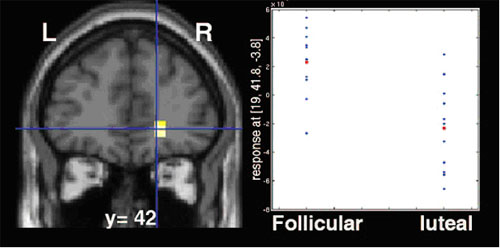Archived Content
The National Institute of Mental Health archives materials that are over 4 years old and no longer being updated. The content on this page is provided for historical reference purposes only and may not reflect current knowledge or information.
Brain’s Reward Circuit Activity Ebbs and Flows with a Woman’s Hormonal Cycle
• Press Release
Fluctuations in sex hormone levels during women's menstrual cycles affect the responsiveness of their brains' reward circuitry, an imaging study at the National Institute of Mental Health (NIMH) has revealed. While women were winning rewards, their circuitry was more active if they were in a menstrual phase preceding ovulation and dominated by estrogen, compared to a phase when estrogen and progesterone are present.
"These first pictures of sex hormones influencing reward-evoked brain activity in humans may provide insights into menstrual-related mood disorders, women's higher rates of mood and anxiety disorders, and their later onset and less severe course in schizophrenia," said Karen Berman, M.D., chief of the NIMH Section on Integrative Neuroimaging. "The study may also shed light on why women are more vulnerable to addictive drugs during the pre-ovulation phase of the cycle."
Berman, Drs. Jean-Claude Dreher, Peter Schmidt and colleagues in the NIMH Intramural Research Program report on their functional magnetic resonance imaging (fMRI) study online during the week of January 29, 2007 in the Proceedings of the National Academy of Sciences.
Reward system circuitry includes: the prefrontal cortex, seat of thinking and planning; the amygdala, a fear center; the hippocampus, a learning and memory hub; and the striatum, which relays signals from these areas to the cortex. Reward circuit neurons harbor receptors for estrogen and progesterone. However, how these hormones influence reward circuit activity in humans has remained unclear.
To pinpoint hormone effects on the reward circuit, Berman and colleagues scanned the brain activity of 13 women and 13 men while they performed a task involving simulated slot machines. The women were scanned before and after ovulation.
The fMRI pictures showed that the reward system responded differently when women anticipated a reward compared with when the reward was actually delivered, depending upon their menstrual phase.
When they hit the jackpot and actually won a reward, women in the pre-ovulatory phase activated the striatum and circuit areas linked to pleasure and reward more than when in the post-ovulatory phase.
The researchers also confirmed that the reward-related brain activity was directly linked to levels of sex hormones. Activity in the amygdala and hippocampus was in lockstep with estrogen levels regardless of cycle phase; activity in these areas was also triggered by progesterone levels while women were anticipating rewards during the post-ovulatory phase. Activity patterns that emerged when rewards were delivered during the post-ovulatory phase suggested that estrogen's effect on the reward circuit might be altered by the presence of progesterone during that period.
Men showed a different activation profile than women during both anticipation and delivery of rewards. For example, men had more activity in a striatum (signal relay station) area during anticipation compared to women and women had more activity in the frontal cortex (executive hub) area at the time of reward delivery compared to men.
Also participating in the study were: Philip Kohn, Daniella Furman, NIMH Section on Integrative Neuroimaging; and David Rubinow, NIMH Behavioral Neuroendocrinology Branch.

Brain activity in the orbitofrontal cortex (yellow), part of the brain's reward system, was increased during women's pre-ovulatory (follicular) menstrual phase compared to their-post-ovulatory (luteal) phase while they were anticipating winning money. Located just behind the eyes, this area is thought to regulate emotion and reward-related planning behavior. Functional MRI data superimposed on structural MRI scan.
About the National Institute of Mental Health (NIMH): The mission of the NIMH is to transform the understanding and treatment of mental illnesses through basic and clinical research, paving the way for prevention, recovery and cure. For more information, visit the NIMH website.
About the National Institutes of Health (NIH): NIH, the nation's medical research agency, includes 27 Institutes and Centers and is a component of the U.S. Department of Health and Human Services. NIH is the primary federal agency conducting and supporting basic, clinical, and translational medical research, and is investigating the causes, treatments, and cures for both common and rare diseases. For more information about NIH and its programs, visit the NIH website .
NIH…Turning Discovery Into Health®
